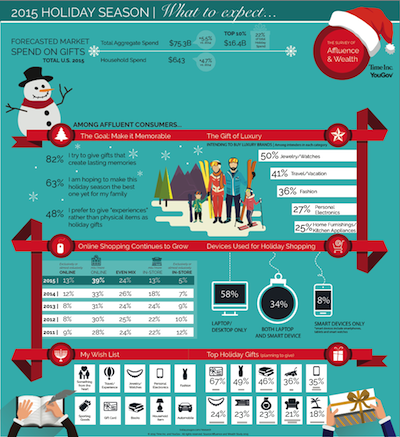The total aggregate spend for gifts this holiday season is expected to reach $75.3 billion, a 5.5 percent increase from the year-ago, according to a new survey by Time Inc. and YouGov.
YouGov’s “The Survey of Affluence & Wealth: 2015 Holiday Season” also determined that the top 10 percent of the affluent population will spend $16.4 billion, which equates to 22 percent of the total holiday spend for the year. Additionally, each household is expected to spend an average of $643, up 4.7 percent from 2014, on gifts for friends and family.
"Instead of considering what has changed year-over-year, a more useful way to look at the data is to consider what has happened since the Recession," said Cara David, managing partner at YouGov, New York. "As a whole, the top 10 persent of U.S. households changed their attitudes towards shopping – including for the holidays – when the Great Recession hit, and their behaviors have remained the same ever since.
"In 2010, the savings rate among affluent families rose to 24 percent of their income, and today the rate has slightly increased to 25 percent," she said. "Additionally, 70 percent of America’s top 10 percent have no credit card debt.
"With this in mind, although 63 percent agree: 'I am hoping to make this holiday season the best one yet for my family,' and 82 percent agree: 'I try to give gifts that create lasting memories,' they are not willing to spend above their means. They purchase what they can afford, and they do so thoughtfully."
Time Inc. and YouGov surveyed 1,076 individuals in the top 10 percent of U.S. households, with an annual disposable income of at least $120,000. The researchers then polled 1,000 individuals in the remaining 90 percent of United States households based on discretionary income. The infographic created for The Survey of Affluence & Wealth: 2015 Holiday Season reflects the top 10 percent of the population.
Tis’ the season
The Survey of Affluence & Wealth broke down what affluent consumers plan to buy for the holidays, ranging from material purchases to planning experiences as well as category interest for gifting.
Additional touchpoints focused in on how and where affluents plan to do their holiday shopping this year compared to years past.
YouGov found that among its respondents the goal for this holiday season is to “make it memorable.” Also, 63 percent shared that they hope to make this holiday season the best one yet for their family.
Eighty-two percent of respondents expressed a desire to “give gifts that create lasting memories,” thus lending support to experiential and personalization trends. This was supported further by 48 percent of respondents saying that rather give “experiences” over a material item as a holiday gift.
"Experience-based gift giving is here to stay," Ms. David said. "For example, affluent families surveyed forecasted their travel expenditures would increase 15 percent this year compared to last.
"Furthermore, 82 percent of the top ten percent want to give gifts that 'create lasting memories' – and what is better than a gift that includes the anticipation of a forthcoming experience, the experience itself and, finally the lasting memories that experience provides?" she said.

The Survey of Affluence & Wealth: 2015 Holiday Season infographic
When asked what type of gifts they planned to purchase in the luxury space, 50 percent still plan to buy jewelry and watches, but travel is gaining with 41 percent of respondents gifting a vacation.
Material goods such as fashion, personal electronics and home furnishings and appliances barely broke the majority. Fashion purchases ranked highest, but only at 36 percent while the remaining sectors trailed at 27 percent for electronics and 25 percent for home goods.
Outside of luxury the percentage of affluents planning to purchase increases across categories, but 67 percent of consumers intend to give gift cards.
According to American Affluence Research Center’s 27th annual Millionaire Monitor, $5.6 billion will be spent on gift cards, the most popular gift of the season.
Gift cards enable the receiver to make purchases that he or she will definitely enjoy, thereby eliminating the awkwardness of unwanted or ill-fitting gifts, but they also represent an opportunity for brands to earn extra revenue on cards that are not fully redeemed (see story).
Holiday how-to
YouGov also found that online shopping continues to grow, but in-store is not yet fully out of the equation.
In 2015, 13 percent of affluent consumers will shop exclusively or almost exclusively online in comparison to 5 percent of respondents who only do their shopping in-store. The mix of online and offline is about a quarter of respondents, with more gravitating toward online shopping at 39 percent.
Consumers who shop both online and offline, but prefer ecommerce shopping has risen 6 percent since the year-ago holiday season. Comparably, shopping exclusively in-store has declined 2 percent since 2014.
For those who shop online the channel in which they do is also a blended approach. YouGov found that 58 percent of its respondents shop only by laptop or desktop and 8 percent on smart devices only. Thirty-four percent take a two screen approach using both laptop or desktop.
Beyond the holidays and in the near-future, retailers plan to grow and invest in Web, mobile and social technologies as these channels continue to yield strong sales results, according to recent survey conducted by CIT Group.
Similar to consumer outlook, most retailers feel confident about sales and revenue growth as 2015 comes to a close and 2016 begins. Ending the year on a high note, 58 percent of respondents of CIT Group’s seventh annual “CIT Retail Outlook” study predict that holiday sales will increase by 6 percent or more (see story).
"Retailers should be mindful that the affluent desire to give gifts that 'expose people to new things (68 percent) – and in many cases, those new things will be luxury products and experiences," Ms. David said. "For example, 50 percent of jewelry and watch gift givers will be purchasing luxury jewelry or watches.
"Many of these shoppers will be dipping their toe into luxury for the first time. Retailers should prepare their associates to be 'welcoming elves,' providing these luxury newbies with a comfortable and memorable shopping experience, while helping them select a truly remarkable gift for their loved ones," she said.
"Retailers take notice: a change we’ve seen since 2011 is that the percentage of affluent who plan on exclusively or mostly shopping online has risen from 37 percent to 54 percent, and those who will shop exclusively or primarily in-store has dropped from 34 percent to 18 percent. In 2012, 55 percent of the affluent said that 'holiday shopping in stores put them in a holiday mood.' Today the number has declined to 50 percent."
Final Take
Jen King, lead reporter on Luxury Daily, New York
{"ct":"hLkB3wAgSVUIOav7T+TDZknOZw0weE+IxTdwM9qO4do34V2tzroUJZRdTawo+xKLT0BtjEmgTZO5TNyeJhqLe3jg37VgkSxOyaFNQXiOcx2pwmK5HY94kGEpGv9KO3Wnk6VMmLUPiTmf9uRVo\/wjYP78K24T+LMSrx29tbBezW7af16H3PL2JvKhTCaX32kGKzvpiIFdjBWTksGf9Y0XmWXTovnhmFy3QSqx2lYxQDhvc+3bhnWUOqJqtLxB51FcJjVW4+9+OXiUdyNDZ44zWizdKKdl8W9NXlGDcCjrghd4FFSNgY21hgkieQvbQsgfb7MKxVWbSx0t5m9La426psE2AoC0AprLG+Nkv9V5i3Mq8zI7aylwHllrWYXO0Z1TvQ4v8WjE4H+No7xUYwZV5242Ny7EMmZ9BnXchjFMxXF2KeDUnXN3JcyXeu5El0IyxDNoLKKSmjaI9gWvHVrPS9dFi2dAlgimgsNOLTlSssJFPZ7DSTPWtMnMxn9z4W23onTwrFMVjFIcwVdrlq3TDHwLHsy3bWmEsY+p2k77G6BP+GdndTl9atxf69swShvUtBsFfAI\/PHkjYJzNP8bPu9EPoueU0SBqSQrVKb4R5pFwdRSsm0EgHLbAPOnExS6qxRNLXuA7KW8TA+jd7elYDLIu8hBLVeYW+p2e0GhKHo817H5P3B8u1NE9pIc7yOCSQEoiRwyVpki8uXQQScRf71FPALRl7nhds2OtMoEDrTNo37WW5GpOV\/czZwva953Xr6sLIGWXWsJrVrn8vbI1KAR6DuyFwxKPb\/eHmUGL5E3uaXDMkp8OsjgCDrVg\/RQl6j8gfK7kUN7pzwhyoI4J3aqdDbJBd5\/dzqVW2M1Lo2j0Z2onmUAwi1AcLCphxxtQ8i7HcrvM0wiSUGCjE1DFm06gBIo5iaZXx8Cmvxh3uy0xp2LUinaK5p1pecbYR1qTfWAzyW4vf8r\/3NegeDmo4NTHK1lthWMDS8D3xf4BZ00sUpDs9MNP0VEwvj9FB8gde3vcu\/cBL\/47qXNhn9ToJk6\/5tERP0ZAV2APCpcz9OX8zQ\/ndIi2TmfcRkINLmAFxtlGVT8k2fl+kMryaTvst9WUy0Ucmbz\/gslAM5aInoAPovbes2gG7TsbTR3qyBp+mrvr2h2GVFmcXZy8rnuZeKDVsBtDd6fpnkVJDClj4630aql14bk5afqNzf93NVejy1B+e+DUcsnQxZVa7V9Ca3Son5+ARJG+ydgSmIA+YQIseJuj7Di5n+IWQO6PHn3ZIBgFfSluEU8rGxAVYn1RSrry7ffDy6BzAeAVm4mQIe+0RUZfav4t6hr65SiMFdnDVwAHO2bl8u5zt7HXbBO+Cg3I\/lOhO0\/27NUZkOP7KuP+lZ4\/c394oPbmPDX0aO+cFpQqiXc+5WmV+McDhl0ZPV9EGrG2\/TC7FyJDXFIwq0kFpQHk1LTOm36V5mwF3LP1WYwAUJlcR35B1IyrPz4FIW54kQ8owjVAzgDhUctiA68QKkT6OfO1jRvCgDIrDrYpD608hMZ1AV2frN2EoiSUlgb6WAek0IEo\/nn30t3ZoN+EBX60gfnENd+lITH8dMQCZjGWgsJeKAHQx\/54PxLYKa\/KKfnntSSZPW\/tooUnyyKDPGCLdqWldUmujU6BByQrj2ND0PfVYsT1eNEqRey\/\/IlGMhEWwReIu3X5vMC9uoKtnw5355Thop1CaXTMxCBlxQoADtAESBGndy8E4saETyOvwaAFriNz0l7zV\/pHXzUdu+urMBGbgyJGg3TBJQfqYCVs0QWcq9P\/c4LOqXFq+Khi3J2gj6IyTkW\/jeg8tNpgYnXlhv41lRG+7swAVxaPxjUKjdx3qJTyGGL9IQDjK0WffYt7PjgNzWTqS8Vx7MrCR7zQelfor7uKiQr\/Il9Sh8Kn5xqMxBBacPrU3EoKB5NSGB74+aEvWh8Y3CN+2AiT4FCVBFnd5aCzVBECzKgye5zyZ8yuHNUSBES7cx80E0ssHCcoOEbFsHYHYog6QBLuyuw+bpnsaU6mIUnPsBcDFmU5awOYQLTAnIhmmnuvWZQpWve62CfAWX7GZ1AIG3N4N6a3kdk\/gYnm8yassW7abt6z\/v7yOm6S4OSMZeL22+5Yr7RT2yLS3MN7TNgOA33DoEPBKniuC+mf4Hj2ko5dCFdWeLCcq7c6Q22Rih+cb+0CVSjXz+VpluKQKhe\/UPAHq90IsHte4L4AiJNOEbb20F4qJEA+jdpRIqny5bja1ygwkKUXXIcGmoPR2ztsRt9JULViEuGe3wQgN1blh4Wxu6dG3gXQXiEYnCC6R6tVJPTLXsU\/DS5MQdoj2kceHk8fx91kRqiZSHfGVcZZl1AogWCw\/n2f6hK7UcOTw1c3nLFDiVccc2SVzsGiv5UlEaXjliD8KMhVo0WcycBPbD30Nz57yOCj39Nim8e0wKM9Xeu3QgxAOZ3\/DY7R5sug+onWex7Mp+bGNhKGaJJhOyyvvKfl6wrvhxyAwDiqtsWC2kR7bmPb2hdn9vSFNcNK\/u7rjH\/d\/6jeEq3nFJ\/9uPX8HjHOPN7zAau5YiVpSGljkr1SX83ybpBn6bXYv90gYsbdsKt7wyV246NeqqWjKmCh0XiL0wpESnCB9EmC9nyEiMgob7t6brqF+yfYUIXyFjFF8gp9n21SaxBvLQBAt08R3tHL3VP7WsC7BlppHbfOukQrTuo6l+NoMlU8Dc8FCbVSU7+YPjciwlThXcHpjZkg8grg0f0ivU35nmwP6N2fWPw5hpFcBhmawH7PsdFSxHeMZKy4DWVqRLoh8ETewIFJBktyuWzsrBlTnCCyM2seF0leoe6kK3jnJ2hhOfcBeKG5+pzA8DX5E0zHf4G7Rityczry9Kz2Y4VC9DCBfsCIcBaBw0ALSwQySz5y9fraug2PU6DtSopW5IOaqMYGsLzxlES\/XsnOqPXJJMVMBVnfErJdSjL7sEHZVlroW4ufKLKgz3Uj1E2DSHxFuTRAbEZXnXsDd+Y7mS9qo7Wu9g2UJoJZQsbvM6\/3N99YNIpA\/ECWmz6T2XVbDmkVXfdzD4ezRA8jZ3Ykfkj6J1oa9dB+eR1qXlGDUy5ZALNwS54QHoM++mCib3DtJbBb7\/bwqJ4UwsBrh0bWrnary33a4h6Xe2rSS1CISgMX7\/1fMnBW5++wkwWsjz8YXNBLANupLnM3W3IXSmkfSEUFeKDFMOR6gS0JYYzUNy8J\/WnputJpdTvRT2Xon5wh0JrO2xrTVcv36InSm0k3OZCEDF1mUr\/8AOD7y93y8Zf31AH04e8VgQpDJFP0A+R9LdlUXY9ULgwmFl+cYB2pRboB8C+ibXbQigewjRTQw6OjYMrr3hcaZHjm4AvLaY6+p9Z20ygCs3GJ7vCEmXRHGjCKi96TVjgr52np0vzlWLUlI3YusJ4Vdim7HShBvwGYBGgTSmKKdc6B8V\/J+Hq8SEbaOsYy0yaiiaGkCM\/5PeQwU9Z71xr+eJ4tditeqwuSj3m137AMadfz0\/RBk5JS+5ChM3ry2SRK7W2AGSZQgxgRiMLS3w8hoIAPy+fu+yVS5W6MzXAtU5LPab\/60tHgpBS2KMlMIja7KxmY3dbDbnQ3og81AKUy47jmEDek61RyiuuNiBQ\/T1Aeu4l07gqbCe1uvxboVxJp7bvZLf3VJOLp82P5CB36lUm04uGzpGcuBbijNcA\/gmIivFWgKewsZeRUh0\/q4gcMTK\/a7FI2kFPw5TviSLGsJrQlgzJHZc5abxrkhlfdJIkcw\/02A4LiFPvEMa3l010yKdeLIcHFtfVABCyN2XC4x\/S9\/oqSUAM3V8rpugT9qvrXw+jI6aH1TDtiNNoeGGrVCV9qJSGmv38rd7S3PGpTEwiXVETNW28Qpeti8wMzm3sHyyYlAd7ROJSOtjJ7H3923omGRf0JqREgsb03R9A7Az\/jNFVkN0\/FY2HkXVXEjINsgVTwjt+o28eFloow9MJmnkBgiIGMs8lzNh2YhTfDiMCnJ6e1+4lob3LzMzaD+OQ36ri5tzFkqMFZtWP1JV5gIdYmKZEz5C+vtn6thCNz6IBJFVfiVYLTYCmRbCEnvNW0fumJ0eACPMcOlBCk1xgeqws\/f3EKL6sc3AVzq4bBmmSuFxrUN82BvfFEJfd2USDZCVJam0ei8hjZ2yxEWm+x0EtP0pgOLDTRIU\/BCR96WhhoWswhKbvgcutIsZ5fvyy2Y1fBHDpex7WVawJH4fUcxHko1HRXLtHWjY+CdVtqzqJmsOi0muLT5EHOOBUPngD8oWLHTRUEE4A\/iZ9hNzMNpedCtHTDnV1fY79JVX668yXU6i7kuwg0zZKjTHeB+q72SffCXhr00\/8nIGDeIZ78WAkQqVZAK9pEYBBmtQXedT1Oom4Q+FulxsyhxPan\/IN\/HoaVkWla2QUuM4z6PWp7UCOsuVTFD4YtwbOzV566+zJhgEo5bbdYygxOs9P+oXUNF+2LfqPWeIe9rUJHJAJLlqFcXG80JRrb2Yr6\/esG+q1UzgkpvHwPOGiiTYZoFBqita2ygwTkDLv2zdWPXyydvYpX0e7avBMw8L5MLocewKe6F68fccHLEWs3nDjqqXBIFVkZLtxg0EoZ4nPLnQLfj0L6OCb8Tdw8VgiFk+tgcSHtdo6nhljHjqZxLiXP5DiEAGT4Rtax+ph1vTqHu8iP+nHBqshoydmGqs4ABPUOd28ZSRrdTgBDFETaI3t0ObdFBASDjVPfx8oaLsQssg0\/0DswTl17i6UaHuDmnOreJhCF1A3zYLXq0dk+4u5aeNh59AXUmVW1Dc\/zujrlsCvC0yep\/c3rf4IZxGjuHHCQGMgMpqtEN\/hc3mN4I\/Kj+hUwXLaG1FaPxuOvAv1JSH2xFXPWszDHTHtk6XtbWDAIoFRHCVY1HfkoLGtY8XrkbmKKfXE0UjfauyUz6wLYTcf4n4qv4UvcrSwsGHdka0mcIeU8rlIgWzfiNeJ5J6QSTSzSg6o5A34O6VMg4TUEGnhyiw2P2SEOJolM+R5y+MuO6S03vec9BwiDZi8XeoAPRX33putIsPpz5wdrSIIqNz7\/xwYKsMhApR\/yRpcyy7098P+8o7JTBtxuJmk46u\/tLwHPlgBVgwFq+yMrnYAsiSbmc\/ETcj95fZGERzXb2UU308ObGNcduHdhakdUOt+w1XvmhgrrSp3TIPUvxdjOw6lLrP6bFCD6YyNFeNhbEpWdtPmfmhdkttKubgb3+NhDSKhyIk+Vxj8OHzjLjzAjJC18I8pCwNGhtXS0rcGh+qyFRqqtPF6PnMiZW\/JXUaT9OaeAyvC1ArhTh24XBAGCeQilWO0RGxszGYgoQ9XlxYYyKgfEp6L3FXZjWu+kxP1\/doIf2+w0qnjtdvLcjpbv3JfUsJ21aOLBEIjkZQ3+jj4eurJpmgyZ51xWZmnFiRuGWYDp5UOitUv\/etUQ+Eu38HilqGabKXIqboZij4x8fEQS3VAskA5kUta+N50iKFUyU9jZVLoWMJTXH7ne+ggzz4r5nKeyHLFoGi3SptVF432khWt8xgdB8QWBVt7z8SqcaXlOt0nNYshXS7BI8HWy3TE4gfJKBVhbBX5G1e\/mR+rKQi3VQ1KpIt3mKeCU+c+sngDm6KaaOVsGtLzDLBSZtQeyXPz+xRlwDbVDfJhsdit0okfLl2hBmKnSq9F5TbhdoXKbN8I2m8xEQet9KiPQ5k3PWpLia1FkLr\/Gp2e67HgHdwxk1ghFjGTCHxSKsMtrOfbRjM4GQLlE9bQG+p68Bbyk4OL0wh4yzwpOfQavIFUvS3H3SZ7CvJWPdK1m\/9vtVcx4iKVoknZq8qRhOuNP1gIoHaTDuxZSispvdH7NWu0zUQilj9THFLWCN9BS76KhhxZtSs8KxfrwC0dvdD51uXoDI2R2UmMtSk5ytgiBbHsnSIPK9LNsxg1rfug2IYMD8Q7XGxpn6gax0Bab6XMQqVH8PtIHl4BpcaVxjw\/+bR3FDT2a6LDshkUXO8NbU\/k2xpi23r52hne2jW7YBnZcQXyb+DaEHcYAbxjhMflFhSbv7FxA9eCE8s3Ttk81jq89ebuRl0MdqvmFmdbQdeShHFEzX0qvi9BqxTtQ7LSQWpLFtoJbS8RbmKYzB8YL4k7MptUCK67n15S4plG4TwMc9FWr2B3yJ34sN7vx0rbLT\/4GM2Dw3oskZyKOxE9NFfvbx0BbiTgwbEEd89bBeRX8VCI0zfdn0icUuwR0KipLtJRO8tHTWt2mMRKquF3y5z4ZFaO1x2RbBKnviRVvyKQ+Pc4Ef\/16h3lMHooBtLZ\/yNnQUEkyEs7oUXgrK93VPfIwuuBs3LQRnRMp8kkou6zhynK1QOoZFXksa2IU6srHLSEq6DyG7gxcIIqZqG6U4eqy8ORzbpax2ltO\/tVYBif86nZQ+e0W6773gpC+Fb084\/jJB7OAz91R6bWpK6gHMvKTDTKyud9mFoZlCSgPPkK8ZUEJgr9IK+\/RfMUedkmh7jn3bKruKljtQTpGIWT0pJRe49IZ976iePKl6PWTGsR+CLT3tyyFUbiUVG28vTUYGhrD435g8Kf0ukTHO7oeL43BB14HLA0TOZcxO5Z20SwbsdGp7PNw75aAm3rFe2VEPTGQgMu2QRcTbOAwlDt1\/nLW64V\/B52gbbGJYuGEAhexqVSnQke5039FFbLg3PcyS\/ZAbIFO+brgGlwfUwGDiqf1a8zkt+GRExKlcYADXBihFeW3Gobp56tGVnfmaefUeET\/gf7nCMEyu1UqxsPlFBDKHfvUBX3ceoKjalpXHnXod6Dk4c+9Q0lgqC3sbUtmrIxhE2qi64+Mf0l++ZMeTovrqL4Kth5rBRyf5lurABrljWNS8V+jfj9Ew9IvD5AGkrHmX\/RWn4sEsTu\/Q1S+bhJblivoa6Rvwh04xAnzPmDxXNZ4O7+DHQtD5buXSUNViKqd95pSzl0\/WBrKM3j\/qNshp0qfPXO3B2aT\/rxEcPKWvqNDeuV9Y6mzZ+8D05x2F7pZRR6qnOVXOkdgG\/IdbELHIAYK9p3Eq0do3ZkFwbBOk+P7ybHESn5vHkaR\/ifMmKN9Y83F7LDMggE1oC1G76sLmYY7fQyeCQmQ\/96Jow7+crbaII45BdSH8\/bRvckSyjcx1d\/NxdUkr8sw3421y3tst9q7jUvsJ\/XMnCYLQk01gKwzzLyyee+Ko4Mm\/XYz7uZxZ8RpaifmrpFJZBOl\/31HJuQrXWDrY1Z5rzQfRfgfWa4JPIOEhrEcERRI5lVRqREUp\/GxubMxOfz2mtiWZVEIZ4Sg3NGOg1RTS4po+nYUh8ieTSZCJGxfk0TgZLpAGEE3wSlAEfVzKF+EcDpQg1DKbx6TY4Iqo8eoUJNXXwUynjgOqkROSWkYbegZp46Yb9l+uuIRvRcKbcLr\/In6hEIlFyNyTky2DsguiCGMV05kpBbu33CId8GYogbGO+MCL7we7XeBhSG\/xm5\/\/Yykp4MLk2XwhmjMCEor+8G\/rjyPlBWS\/+i2XNME50AkjVOohTL\/8VDxuXBSB9BBtd3N8Hl35ezvqPbSppcPIr3YvrT4zbjiKIKBwyRHTNsjF\/K0I+zcUBB6zUTADth6IkANnIIo\/kVxT96uuIg47uY2ZoYLeGNbXcQ6bpIzHMd73qw1cO007bBggFWNPJ6TXQ1q2EFQTyPKqMLVYJJQw4ZrT+w1Y\/sg2NVjl5FqNVAVonM0bdaIEc7OlYZ+gtIfDWwD0\/WMCHRzlrhPqbdei6ZdtATRfTY7Z1Kzzz+jS\/s04YQ2nqb10RMemPJh4m6spQB08glhqYUNAaJ3CMc2F2oVDGY4igkGz9fjPkXrFaJkK2FkLwVSsmZAXTKv0TN+HGZOvu0FyrdiezWhW5wyMkNQjCEoRm\/cN\/MjFWPKs6g0q5XdbidDoVsBiFEEt0jCn7rfgMtacxzv3c2\/HrybrN7KVcbX+hcUcYsIWoJ0eppdnxRROsa13RtU7HAIjIuD1ODL5f\/vg4Goc1vJztpi7cQGLIuYChFE89G6R6s+SgtGEeK0hd9cjrrxG59DdIUUhlpZ\/T5Rz\/lqtlR0R0A3t1Mj7hd6RXRnyn4KM5hKw\/Lh16yKjR25ZhXJm3SC1sBT1ogD2KeCE7FK+eUI0Sp77avYvGJ9+vnrCqcLtdncaoH3xRyxVHErllZrDrDuzemqpDRNTwvztSUMT9tg3cZWHQexuT3wOg2\/7Jy558A3pUB+k67hhm5Abx243Z6Pt0OYswgVM3jVx\/vbAosqKo1UwP6GKtskf2FAf56LEiM4B2onTBWZvHRHApBqxaEo1Vx0j4lfZzUjHlYCtcI6n76MJx96nXbhFrbsxXQBn0FDCauCRQoT8+ENBA6WMeVWjk6mFkuM9GCEGvs1OnO00Z\/QvA\/DP0oionBXjodNOvG3A2gD5eNOHToSpbNTKH9j8c9+Wpy7US868LL9nW5L3OF8UzU7ulToAHIp+8KGLk0mKjRuhtYoRDmUsekRrAqrmEeYehlIYjrhht2nmqi0WCVXLhhTIydDdHZHY65O+Dt\/7N+mzeJh6F4noy1Vq4SsdDoFqH8joXCJn1JJWxUgdv085VXJWGAJFBQsju8+UK29\/O+FuBN\/WS4YlkgBFrCPo8ANePNR5kygmvvIWFtsN+IfDpesDWpez+3xl0yDn8Ne284gKyiPHKynEGi82cMzD6XxuYq6O4FzS5P8rM4sWAzDFrhenuVuu7T0HKXyiM+rbhzFQZd2+4HvaLJSTcEMQYwACadmw60FbhToU+N6BXtbidS0mHUw9AouLT06+w7FVQrzjYn+LpZqMWkPJBUIXvh8Hfll6ViJk0YUrL3FKUCnItAByycYvSnkuH+MF4cCHWn9Mv7Ryn\/qsn\/AHvyRVZBxMwrYo+PBvY4JtpdYwAeCGULHD4kbweamPQzuo7G4lFYEbd3lG\/4WHDuRNl7r2aO\/wDdumrdWZcq1mHeFQt1W\/m1q5qWG4MCGd8L+rq9LBz5tb3Qn+zQz5JShitcpDZRrTCEsNc7kC3K0B579JtXZ4Zym3ZP5qSVGw8X6rZ8n5jX6\/wB0OpKODC+P53ulu+vpQlSHUz5tvEQ6rOcYA0xE254EEhDGA6wI9e3HqGHEIIbYU2rHqcZhi65+cdOWZ6s6kTJ0pv5ofEv7V3f3rUNm9zFKVNj2d6TvTr8cs9hCRhj+v4y7uFLa1xTeuIfzeDb2VohI9ufOXfMUBtBU72xikfiAs6hDUa4G8UJ3pMnMgOYuiZjKId49\/MBty3PcASDiFGNoC8BpZXfjURUKqaN321KGd14Ly4hnt7OKTQxlQAGT5ZFRahWyjx\/a4XTRE6WTJTseA8k2GLR716OgsRTiBTJ420HELfjT9zKIcMkEz9fkkQRK1X3VyCEMMEUUBPLFoQdCCDP9Mt\/GUpeHSMb20er+cftbCFdcuUGDn2yNHFAK\/z\/gair0+ztRfbFk8Yz8Mp9IgpkSGPmpO3fnM0VqzCQN+BsKy5B1OiiTXoNmR+VkH+4n+7hot4s9JsMY3rsBSUl1KIFOnmdq\/vOo7gy1d8YdC5SsB5AB2Eibv5i8HUOOLfwUK5zn3QTc0n1sp1xMbcwPf\/oBdb9UJmARDoh266kS9o3BpgUm\/tTOYwKiI7zkCf4viXTx1StZ\/NOBdidDGrp5kjdtcDQz9qwcfMda1Afb4tWT7TwUmtTOPw4j7YeRS3Eeph4+FcZLIQ1hdeFUFzmQxbrXoOQblX9wXvYzoqdRYjR2lT3bOwnKiz1f71ui4yyfKALdVZy2MUDmdL0xlANyoEZT0GEcZo7VKYlDXPRSlOe5EzkfEMgQtNBQvpU+XBHnMEWjE1VK6qQkyYqMei2zww\/jRW4s1u6iAxFftrlISOaZJvrW6ILjCwJMYmhh\/vhASG8HJ9msuQrARdZbIpnYv2WdAOhP6Q48n+m+nFP6z+yZsoKK9\/\/eF\/MCsZD9zUH9BnuEbuc4\/OrpDKk\/n8wQ1otpsykaejbfrPM8tIz+VLQ68SML54M56Sn0I4otw4iW0EnTLZEnAK8PjbWXqmTqGfkCZBG6LRl9r\/8++E183gf\/56M6xnmrb1VHCyWpgXbPVvbyOkD1WpYdaOVC0N8wYwDTZcU\/VKh5rSXficlBgOuCnQLLicmw\/hZQTWzV\/13wauS3ggKvpt\/hg3zr8F5n\/wPEOQfuy3JfdKfhTjhH5ZKKZy8bit7xjeXjnSAjo6cm5WYKwIWaOId040Aa1vP9x998n5DuSsS7FB6J\/+3+YHCrenLHzJV+GNlF09N+toKh175Ui4MHRw7D+11q35PZg1+FF5MekP\/iH8noTRFzJdIjS\/zbvNRiwYtb98LxT4wcYWvmltdGtUowlVMT6sNvbSmEnIQYUmCCFfgCGqgXZAbsDsGs1L67FvoP20mp9s2Rbh3m4an7jrCX9WJ9dVdfRrckh0A0GRunOA9e7b51Fw2ISDxK6jp3xY9yyQIH6zrXhCdaoCJocBVjWnQdETjDlwfvDNJ7Misj0m32HX\/wbfkP45LalzMgwTKBkr8WUa+ggznQdWd2YDR4JmUY9SYDojZQmkb4RrPXPiNCkH0yDcaOKc6pOC67fWz1vL3mOnFDTq3PGTowL0EKIsvBeXxsS9S\/WRecg4OqhZ5jpRJC8eE34Htxkf8c5pQZ4v3m+TU1FqOuzw0nIs6mLZxnveE7trN0j+ngYMS9gj5+EUnmGd9DA\/UImhYU9BxB8osLQiJr4HchNBlz9Y2iUAjcLnsp5jY9lVIXigtMOg71nlLPsJoeQxuiNaWojp++W41EWy2UVjRI1B3ImkHl5PfQXQvFrup32d6k9HtjN4dtnKPBL7ap2QPSRxAhCGBT0ngj+gvUOCXMpbyxv2KA8BdrU8ir+8+7B0XXL60LIBHV7CO1vWRg7tvvlu6ifYtw+sviknDUSHqa2wzekp+miZe8cHTAjIA8VczenCCCcS7zYtQuLarrTP6dlk4GoEI\/ITGDm4s2KfHALI07Ezd1fmyYBcQ+q0VJqz2egO4j9u51avdyttpGaCVdFO2W0XPNMK5wfJ4M2bWYz1VKx\/Gea8tJ3QppsGcH\/eIjQLubjb902zFCERVorko+jHzY70gTkcGmbT00clTQm+DOTs90SLHHxI41YhRSLwL8BND6sjGYYmDc4eI3py+yGpJxjbbqDysSATuxvhBiFc01rXcguAVZIfEyaiinYQ70x34dcA1R1kuldSJ1k7O\/148vXA2df+oUfLT8n+hTU6FQLlnv1Q6nksVD3uAnPBMje13yYIQ5vBBd\/1wIXx8WLBsIdeuXVJJHu0pAL+EDi5l9ZEXYe\/QBPwdzJV3L\/LirvmDt8P80hA9krXa4rWZtzRFh6jtOd98ExbHcnQezfyff5KJVwvomNCvCPt+wAuhNEgtPtY0y4pawMiNtk5DHYEC2Tr1SKwNgBV6iFvTU8gYJbwp8iiyvcwY4tELPd8p903WDRKvzTzCKIlJu0sXTuJ\/l6OgSPcN+g3Fx5uOQ9\/IJcmf6kAkBJxNI4WcjEmbX0z4eFTqDCVpRX\/\/bPhNhRwPmia0j+4Di1qHLxdxjCQQJVbEb5Oo7ewzos7RV8nOS","iv":"b6e5d899968698ea6f39afb0aca94ed3","s":"bd637c73b20874bc"}

 Affleunt consumers prefer experiences over material goods
Affleunt consumers prefer experiences over material goods